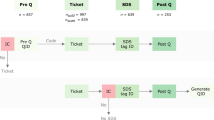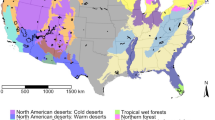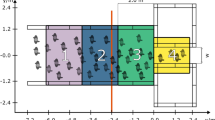Abstract
Here, using publicly available traffic camera feeds in combination with a real-world field experiment, we examine how pedestrians of different races behave in the presence of racial out-group members. Across two different New York City neighbourhoods and 3,552 pedestrians, we generate an unobtrusive, large-scale measure of inter-group racial avoidance by measuring the distance individuals maintain between themselves and other racial groups. We find that, on average, pedestrians in our sample (93% of whom were phenotypically non-Black) give a wider berth to Black confederates, as compared with white non-Hispanic confederates.
This is a preview of subscription content, access via your institution
Access options
Access Nature and 54 other Nature Portfolio journals
Get Nature+, our best-value online-access subscription
$29.99 / 30 days
cancel any time
Subscribe to this journal
Receive 12 digital issues and online access to articles
$119.00 per year
only $9.92 per issue
Buy this article
- Purchase on Springer Link
- Instant access to full article PDF
Prices may be subject to local taxes which are calculated during checkout


Similar content being viewed by others
Data availability
All data necessary to replicate the analyses and figures in this paper and supporting information are available at https://dataverse.harvard.edu/dataset.xhtml?persistentId=doi:10.7910/DVN/Y9QEUK.
Code availability
All code necessary to replicate the analyses and figures in this paper and supporting information are available at https://dataverse.harvard.edu/dataset.xhtml?persistentId=doi:10.7910/DVN/Y9QEUK. R (open source, version 4.1.0) was used for data analysis.
References
Wang, Q., Phillips, N. E., Small, M. L. & Sampson, R. J. Urban mobility and neighborhood isolation in America’s 50 largest cities. Proc. Natl Acad. Sci. USA 115, 7735–7740 (2018).
Kinder, D. R. & Sanders, L. M. Divided by Color: Racial Politics and Democratic Ideals (Univ. of Chicago Press, 1996).
Hutchings, V. L., Valentino, N. A., Philpot, T. S. & White, I. K. The compassion strategy: race and the gender gap in campaign 2000. Public Opin. Q. 68, 512–541 (2004).
Schuman, H., Steeh, C., Bobo, L. & Krysan, M. Racial Attitudes in America: Trends and Interpretations (Harvard Univ. Press, 1997).
Dovidio, J. F., Kawakami, K. & Gaertner, S. L. Implicit and explicit prejudice and interracial interaction. J. Pers. Soc. Psychol. 82, 62 (2002).
Dovidio, J. F., Kawakami, K., Johnson, C., Johnson, B. & Howard, A. On the nature of prejudice: automatic and controlled processes. J. Exp. Soc. Psychol. 33, 510–540 (1997).
Word, C. O. et al. The nonverbal mediation of self-fulfilling prophecies in interracial interaction. J. Exp. Soc. Psychol. 10, 109–120 (1974).
Willis, F. N. Initial speaking distance as a function of the speakers’ relationship. Psychon. Sci. 5, 221–222 (1966).
Hendricks, M. & Bootzin, R. Race and sex as stimuli for negative affect and physical avoidance. J. Soc. Psychol. 98, 111–120 (1976).
Brown, C. E. Shared space invasion and race. Pers. Soc. Psychol. Bull. 7, 103–108 (1981).
Bogardus, E. S. A social distance scale. Sociol. Soc. Res. 17, 265–271 (1933).
Hall, E. T. & Hall, T. The Silent Language Vol. 948 (Anchor Books, 1959).
Liberman, N., Sagristano, M. D. & Trope, Y. The effect of temporal distance on level of mental construal. J. Exp. Soc. Psychol. 38, 523–534 (2002).
Bar-Anan, Y., Liberman, N., Trope, Y. & Algom, D. Automatic processing of psychological distance: evidence from a stroop task. J. Exp. Psychol. 136, 610 (2007).
Matthews, J. L. & Matlock, T. Understanding the link between spatial distance and social distance. Soc. Psychol. 42, 185 (2011).
Hoxter, A. L. & Lester, D. Social distance evaluations in white and african-american students. Percept. Mot. Skills 80, 478 (1995).
Koslin, S. C., Amarel, M. & Ames, N. A distance measure of racial attitudes in primary grade children: an exploratory study. Psychol. Sch. 6, 382–385 (1969).
Gatrell, A. C. Distance and Space: A Geographical Perspective (Oxford Univ. Press, 1983).
Kerkman, D. D., Stea, D., Norris, K. & Rice, J. L. Social attitudes predict biases in geographic knowledge. Prof. Geogr. 56, 258–269 (2004).
Maddox, K. B., Rapp, D. N., Brion, S. & Taylor, H. A. Social influences on spatial memory. Mem. Cognit. 36, 479–494 (2008).
Enos, R. D. The Space between Us: Social Geography and Politics (Harvard Univ. Press, 2016).
Aiello, J. R. & Jones, S. E. Field study of the proxemic behavior of young school children in three subcultural groups. J. Pers. Soc. Psychol. 19, 351 (1971).
Kawakami, K., Phills, C. E., Steele, J. R. & Dovidio, J. F. (Close) distance makes the heart grow fonder: improving implicit racial attitudes and interracial interactions through approach behaviors. J. Pers. Soc. Psychol. 92, 957 (2007).
Goff, P. A., Steele, C. M. & Davies, P. G. The space between us: stereotype threat and distance in interracial contexts. J. Pers. Soc. Psychol. 94, 91 (2008).
Key, Jr, V. O. Southern Politics in State and Nation (Knopf, 1949).
Massey, D. S. & Denton, N. A. American Apartheid: Segregation and the Making of the Underclass (Havard Univ. Press, 1993).
Trounstine, J. Segregation and inequality in public goods. Am. J. Pol. Sci. 60, 709–725 (2015).
Allport, G. W. The Nature of Prejudice (Basic Books, 1979).
Enos, R. D. What the demolition of public housing teaches us about the impact of racial threat on political behavior. Am. J. Pol. Sci. 60, 123–142 (2016).
Enos, R. D. Causal effect of intergroup contact on exclusionary attitudes. Proc. Natl Acad. Sci. USA 111, 3699–3704 (2014).
Dabbs Jr, J. M. & Stokes III, N. A. Beauty is power: the use of space on the sidewalk. Sociometry 38, 551–557 (1975).
Knowles, E. S. Boundaries around group interaction: the effect of group size and member status on boundary permeability. J. Pers. Soc. Psychol. 26, 327 (1973).
Henley, N. Body Politics: Power, Sex, and Nonverbal Communication (Prentice Hall, 1977).
Washburn, S. L. & DeVore, I. The social life of baboons. Sci. Am. 204, 62–71 (1961).
Evans, G. W. & Howard, R. B. Personal space. Psychol. Bull. 80, 334 (1973).
Goffman, E. Relations in Public: Microstudies of the Social Order (Allen Lane, 1971).
Willis, F. N., Gier, J. A. & Smith, D. E. Stepping aside: correlates of displacement in pedestrians. J. Commun. 29, 34–39 (1979).
Silveira, J. Thoughts on the politics of touch. Women’s Press 1, 13 (1972).
Sobel, R. S. & Lillith, N. Determinants of nonstationary personal space invasion. J. Soc. Psychol. 97, 39–45 (1975).
Thayer, S. & Alban, L. A field experiment on the effect of political and cultural factors on the use of personal space. J. Soc. Psychol. 88, 267–272 (1972).
Cameron, A. C., Gelbach, J. B. & Miller, D. L. Bootstrap-based improvements for inference with clustered errors. Rev. Econ. Stat. 90, 414–427 (2008).
Abadie, A., Athey, S., Imbens, G. W. & Wooldridge, J. When Should You Adjust Standard Errors for Clustering? Technical Report (National Bureau of Economic Research, 2017).
Cottrell, C. A. & Neuberg, S. L. Different emotional reactions to different groups: a sociofunctional threat-based approach to ‘prejudice’. J. Pers. Soc. Psychol. 88, 770 (2005).
Harris-Lacewell, M. No place to rest: African American political attitudes and the myth of black women’s strength. Women Polit. 23, 1–33 (2001).
Goff, P. A., Jackson, M. C., Di Leone, B. A. L., Culotta, C. M. & DiTomasso, N. A. The essence of innocence: consequences of dehumanizing Black children. J. Pers. Soc. Psychol. 106, 526 (2014).
Sands, M. L. Exposure to inequality affects support for redistribution. Proc. Natl Acad. Sci. USA 114, 663–668 (2017).
Dotsch, R. & Wigboldus, D. H. J. Virtual prejudice. J. Exp. Soc.Psychol. 44, 1194–1198 (2008).
McCall, C., Blascovich, J., Young, A. & Persky, S. Proxemic behaviors as predictors of aggression towards Black (but not white) males in an immersive virtual environment. Soc. Influ. 4, 138–154 (2009).
McCall, C. in Social Behavior from Rodents to Humans (eds Wöhr, M. & Krach, S.) 295–308 (Springer, 2015).
Steele, C. M. Whistling Vivaldi: How Stereotypes Affect Us and What We Can Do (W. W. Norton & Company, 2011).
Sue, D. W. et al. Racial microaggressions in everyday life: implications for clinical practice. Am. Psychol. 62, 271 (2007).
Weisbuch, M., Pauker, K. & Ambady, N. The subtle transmission of race bias via televised nonverbal behavior. Science 326, 1711–1714 (2009).
Dietrich, B. J. in Exploring the C-SPAN Archives: Advancing the Research Agenda (ed. Browning, R. X.) 241–258 (Purdue Univ. Press, 2016).
Acknowledgements
We are grateful to J. Anastasopoulos, D. Carpenter, M. Craig, D. de Kadt, R. Enos, J. Grimmer, M. Hibbing, H. Jefferson, G. King, A. Theodoridis, C. Wong and audiences at the American Political Science Association annual meeting, the Midwest Political Science Association annual meeting, the New York University Center for Experimental Social Science conference, Stanford University, the University of California, Riverside, the University of California, Berkeley and the University of Iowa for helpful feedback. The authors received no specific funding for this work.
Author information
Authors and Affiliations
Contributions
B.J.D. and M.L.S. contributed equally to the authorship of this manuscript.
Corresponding authors
Ethics declarations
Competing interests
The authors declare no competing interests.
Peer review
Peer review information
Nature Human Behaviour thanks Christopher Marshburn and the other, anonymous, reviewer(s) for their contribution to the peer review of this work.
Additional information
Publisher’s note Springer Nature remains neutral with regard to jurisdictional claims in published maps and institutional affiliations.
Supplementary information
Supplementary Information
Supplementary Figs. 1–21, discussion and Tables 1–8.
Rights and permissions
Springer Nature or its licensor (e.g. a society or other partner) holds exclusive rights to this article under a publishing agreement with the author(s) or other rightsholder(s); author self-archiving of the accepted manuscript version of this article is solely governed by the terms of such publishing agreement and applicable law.
About this article
Cite this article
Dietrich, B.J., Sands, M.L. Seeing racial avoidance on New York City streets. Nat Hum Behav 7, 1275–1281 (2023). https://doi.org/10.1038/s41562-023-01589-7
Received:
Accepted:
Published:
Issue Date:
DOI: https://doi.org/10.1038/s41562-023-01589-7



